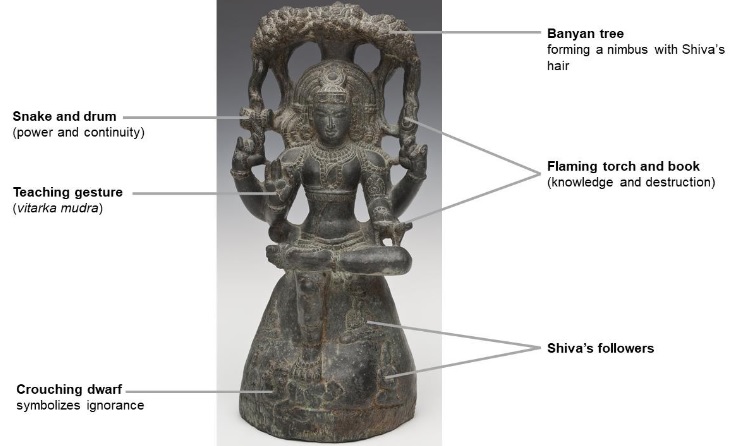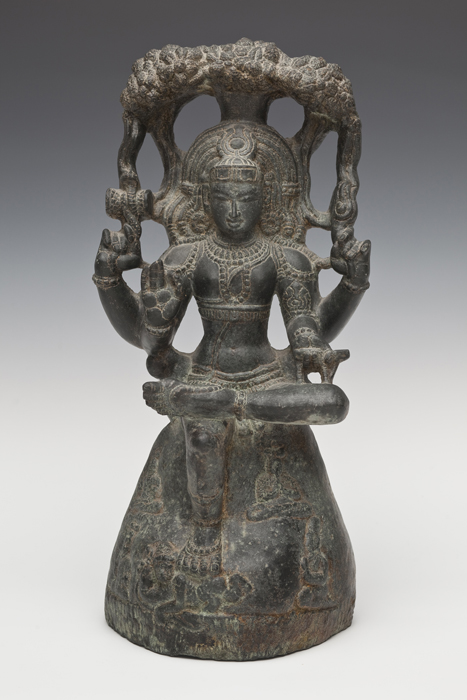

Unknown
Indian (active Tamil Nadu)
Shiva as the Supreme Teacher (Dakshinamurti), 12th c. CE, Chola period
volcanic stone, green
17 ¼” x 8 x 5 1/2 in.
SBMA, Gift of Dr. Robert and Dr. Ann Walzer
2011.41
RESEARCH PAPER
Dakshinamurti, an avatar or manifestation of Lord Shiva, is seated in the position of the Supreme Teacher, the embodiment of knowledge and destroyer of ignorance. Portrayed in human form, he is shown as a youthful yogi who, in this beautifully composed image, personifies the central concept of Dakshinamurti – only through Shiva’s infinite wisdom and grace can one attain supreme knowledge of the self and attain enlightenment.
He is under a banyan tree, the tree of knowledge, with the branches forming a nimbus or halo, and seated with his right leg coming down and crushing a dwarf who symbolizes ignorance. His left foot lies folded on his lap. The base shows several sages receiving his instructions.
Dakshinamurti is generally shown with four arms. His lower right hand is in a mudra or hand gesture which signifies knowledge. His upper right hand holds a coiling snake and drum, a sign of wisdom and eternity, while both his left hands hold emblems of knowledge - a book and a flaming torch. Emphasizing his royal nature, the deity is adorned with necklaces, bracelets, and ornaments across his torso, arms, wrist, ankles and feet. More jewelry embellishes his elaborate hairdressing of matted curls. The Urna (third eye) on his forehead signifies his wisdom of seeing beyond the apparent.
Dakshinamurti literally means “The one who is facing south”, but a more apt translation would be “Favorable Form”. The term originally referred to the southern, benevolent face of the Panchamukha (five-faced) Lord Shiva. Five is a sacred number for Lord Shiva, each face has a particular name and power. The five aspects are: the five elements, the five senses, the five organs of perception, and the five organs of action, and one face looking up as guardian of the universe.
This is a beautiful sculpture of an avatar or manifestation of the Hindu deity, Lord Shiva. Hinduism began in 1200 to 800 BCE and consists of multitudes of deities in superhuman form. Hindu’s Great Trinity consists of Lord Vishnu, Lord Brahma and Lord Shiva. Lord Vishnu was the first god: he dreamed the universe into existence and then created Brahma, the first being. He is a preserver and protector. Lord Brahma is the Creator; He created the heavens and earth, and the male and female.
Lord Shiva, one manifestation of whom is depicted by Dakshinamurti, is the Destroyer and Creator; he periodically destroys the world so it can be recreated. His symbol is the linga, an upright phallus, which is represented by a rounded column. The linga is the embodiment of the primal energy of the universe and is in nearly every Lord Shiva temple and shrine. Another more famous avatar of Lord Shiva is the dancer, Nataraj. He has one raised foot and is encircled by a ring of flame. Nataraj is the King of Dancers whose movements signify the life-death rhythm of the universe. Lord Shiva is a complex deity – destroyer and creator, benevolent and fearsome, ascetic and erotic.
He was popular in the Southern states of India. And almost every ancient temple of Lord Shiva in Tamil Nadu, a southern state in India, has a shrine dedicated to Dakshinamurti. A stone image is commonly placed in a subsidiary shrine on the Southern wall.
The Chola schools of art are among the highlights of Indian civilization and are renowned for depicting their gods with great skills and lively expression.
This green stone Dakshinamurti reflects the Chola style in a convincing way, striking in his solid position as if seated like a rock, contrasting beautifully with his elegant posture and supple arms. The Chola style can, also, be seen in our museum’s two South Indian bronze sculptures, Dancing Krishna, who is an avatar of Vishnu, and Chandesvara, a Shiva saint.
Hindus believe that it is only through worshiping Dakshinamurti will one’s ignorance be removed and one can be redeemed from the suffering of this world and be reborn in Nirvana, the Perfect Place of Peace!
Prepared for the Santa Barbara Museum of Art Docent Council
by Linda Adams, 4/19/2012
Bibliography
Rene-Yvon Lefebvre d’Argence and Terese Tse. (2001). Indian and Southeast Asian Stone Sculptures from the Avery Brundage Collection. Kodansha International Publications for the Pasadena Art Museum
Santa Barbara Museum of Art, April 2012 Newsletter, Asian Art
Marcel Nies, Oriental Art
SBMA CURATORIAL LABELS
Shiva, the Hindu deity of destruction and creation, is shown here as a youthful yogi teaching his disciples. Seated under a banyan tree, Shiva’s matted hair (sign of an ascetic) connects with the spreading branches, forming a divine nimbus. This form of Shiva personifies the central concept of the religious text "Dakshinamurti Upanishad"—only through Shiva’s infinite wisdom and grace can one attain supreme self-knowledge and be saved from the bondage of the ephemeral world. The text is especially influential for Shiva worship in southern India. By the 10th century, statues of Dakshinamurti became customary on the outer walls of Shiva temples in Tamil Nadu.
- India, Southeast Asia, and Himalayas, 2022
Seated on cosmic Mount Meru beneath a banyan tree, holding hand-drum (damaru), flame and book, and making the gesture of reassurance (abhaya), with ascetic students below.
- Puja and Piety, 2016
